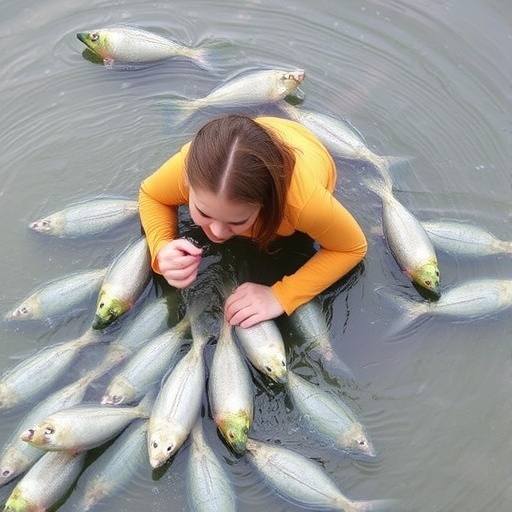In recent years, the aquaculture industry has witnessed significant advancements in both breeding and transportation methodologies. Among the various species cultivated, Rohu (Labeo rohita) has emerged as a cornerstone of freshwater aquaculture in South Asia. The focus on Rohu is not only due to its economic viability but also its nutritional value and adaptability to various environmental conditions. In their recent study, Das, Uddin, and Pandit delve deep into the pressing issue of transportation carrying capacity for Rohu fry, presenting innovative insights into water quality parameters that are vital for the successful transfer of these aquatic organisms.
Transportation is a critical phase in aquaculture, especially when it involves moving fry from hatcheries to grow-out farms. The stress associated with transportation can lead to significant mortality rates if not managed properly. The researchers meticulously investigated the various factors contributing to the survival of Rohu fry during transport. Key elements such as water temperature, oxygen levels, and the presence of harmful metabolites were examined to determine optimal conditions for maintaining high survival rates during transit.
A primary focus of the study was to understand how changes in water quality parameters directly influence the physiological responses of Rohu fry. As fish are ectothermic organisms, their metabolic rates are heavily influenced by water temperature. The researchers discovered that maintaining an optimal temperature range is crucial for minimizing stress and promoting survival during transportation. Deviations from this range can lead to increased susceptibility to diseases and higher mortality rates, underscoring the necessity of precise temperature management during transit.
Oxygen levels, a vital component for sustaining aquatic life, also played a pivotal role in the research findings. The team highlighted that low dissolved oxygen concentrations can result in hypoxia, causing increased stress and even asphyxiation in fish. Therefore, the study advocated for the implementation of effective aeration systems during transportation to ensure that oxygen levels remain within the acceptable limits. The consequences of neglecting oxygen management can be devastating, affecting not only the health of the fry but also the economic viability of aquaculture operations.
Moreover, the researchers examined the presence of ammonia and nitrite, two toxic metabolites resulting from fish waste, in the transport water. Elevated levels of these substances can severely compromise fish health, leading to high mortality rates. Through their experiments, the authors identified a direct correlation between the concentration of these harmful compounds and the survival rates of Rohu fry. This finding emphasizes the importance of using clean and well-monitored water during transportation, as well as strategies to mitigate waste buildup.
In addition to highlighting the importance of specific water quality parameters, the research team also introduced approaches to enhance the overall welfare of fish during transport. One such approach involves the use of newly developed transport containers designed to minimize stress. These containers facilitate better circulation of water and allow for adequate space, thereby reducing the chances of physical injury and aggression among fry during transport.
Another innovative aspect of the study includes suggested methodologies for monitoring water quality in real time during transport. By utilizing portable sensors and advanced monitoring systems, aquaculturists can track changes in temperature, oxygen levels, and other critical parameters, allowing for immediate adjustments as necessary. This proactive management approach can significantly enhance survival rates and contribute to more sustainable aquaculture practices.
The study led by Das and colleagues does not only serve as a guide for optimizing transportation practices. It also opens the door for future research avenues examining the physiological and biochemical adaptations of Rohu fry under varying environmental stressors. As the aquaculture industry faces continuous pressures from climate change and overfishing, understanding how species like Rohu can be effectively cultivated and transported will be essential for maintaining food security and ecosystem health.
In summation, this comprehensive investigation into the transportation carrying capacity of Rohu fry introduces essential insights into water quality parameters that can significantly influence survival rates. The findings underscore the necessity for ongoing innovations in aquaculture practices and raise awareness about the importance of understanding the biological needs of aquatic organisms during the critical phase of transportation. By prioritizing precise management of environmental conditions, the aquaculture sector can improve the welfare of fish, enhance yields, and ultimately contribute to the sustainability of global fish supplies.
As the research progresses, it will be vital for aquaculture practitioners to stay informed about these developments and their implications on farming methods. The insights offered by this study are a testament to the importance of research in addressing challenges within the aquaculture industry and ensuring that it continues to thrive in the face of evolving environmental challenges.
Future studies should focus not only on Rohu but also on other economically viable species, exploring their specific requirements during aquatic transport. Understanding these dynamics will be essential for the advancement of aquaculture, directly benefiting producers, consumers, and the broader ecosystem.
The results of this research illuminate a pathway toward optimizing fish transportation practices, integrating sound scientific principles with practical applications to foster sustainable aquaculture. This collaborative effort among researchers, fish farmers, and policymakers can pave the way for a more resilient aquaculture industry, ensuring that it continues to support communities while addressing the challenges of environmental sustainability.
The balance between productivity and ecological responsibility is crucial in today’s aquaculture landscape. By implementing the recommendations from this study, stakeholders can take substantial strides toward achieving this balance, securing both economic returns and the health of aquatic systems.
Subject of Research: Rohu (Labeo rohita) fry transportation carrying capacity and water quality parameters.
Article Title: Investigation of transportation carrying capacity of Rohu (Labeo Rohita) fry: insights into water quality parameters.
Article References:
Das, R., Uddin, M.S., Pandit, D. et al. Investigation of transportation carrying capacity of Rohu (Labeo Rohita) fry: insights into water quality parameters. Discov Anim 2, 40 (2025). https://doi.org/10.1007/s44338-025-00071-0
Image Credits: AI Generated
DOI: 10.1007/s44338-025-00071-0
Keywords: Rohu, aquaculture, transportation capacity, water quality, fish welfare, oxygen levels, ammonia, transport conditions, survival rates.




